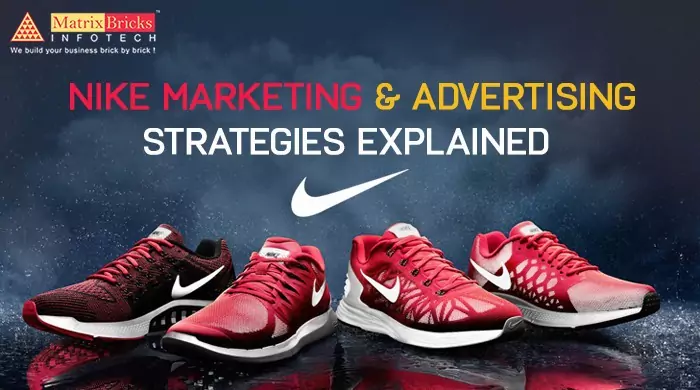
Nike is a major publicly traded sportswear, footwear and equipment supplier based in the US which was founded in 1962 originally known as Blue Ribbon Sports. Nike is the world leader in the manufacturing of sportswear and gear with more than 47 market shares across the global.
Nike produces a wide range of sports equipment such as running shoes, sportswear, football, basketball, tennis, golf, etc. Now Nike follows the global fashion trends and is well known and popular in the youth culture and hip hop culture to supply some fashion products. Nike recently teamed up with Apple Company to produce the Nike+ products which can monitor a runner’s performance through a radio in the shoe that can link to the iPods. Besides that, Nike also becomes the top of three companies which are climate-friendly companies which build a better image to customers.
Nike’s excellence marketing strategies are their energy to achieve their market goals. Nike believes the “pyramid influence” that the preferences of a small percentage of top athletes influence the product and brand choice. So Nike contracted with many athletes’ spokesperson, professional teams and college athletic teams to advertise and promote their products to customers. Nike seriously pays attention to the technology producing, design and selling such as e-commerce, high-tech running shoes, Nike+ with Apple, etc. Nike outsourcing their products most of the factories are located in Asia such as China, Indonesia and India.
Nike put a heavy proportion in their marketing strategies and products design. In order to sustain their dominance in the industry and retain their competitive advantages, Nike actively responds to the market trends and changes in consumer preference by adjusting their marketing strategies, the mix of existing product offerings, developing new products, styles and categories, and influencing sports and fitness preferences through various marketing strategies. Now we discuss the pros of Nike’s core marketing strategies and related them to the relevant marketing theories help us to depth understanding.
More efficient product distribution is the more sales and thus more profits. The delivery of the right products and at the right time to the customers not only affects the utility but also leads to high levels of consumer’s satisfaction and loyalty. Nike distributes its products on different level basis. The high premium products are given to certain distributors while leaving the low priced products to be sold at highly discounted prices at the retail stores such as Wal-Mart.
Nike has become the leader in e-commerce by being the first to the market with its e-commerce website. Nike launched its e-commerce site in April 1999 by offering 65 styles of sport shoes to the US market for purchasing. This program represents the first time a company has offered mass footwear through the Internet and provides competitive advantages to Nike.
Nike makes contracts with some celebrity athletes which can draw attention to their products such as Tiger Woods, Ronaldo. This has created a relatively high level of Nike’s awareness. Besides that, Nike also employed a large amount of advertisements through the mass media. Nike’s brand images, including Nike’s name and the trademark are considered to represent one of the most recognizable brands in the world. The Nike name and associated trademarks have appeared from players’ shirts, pants and everywhere. Their aggressive advertising campaigns, celebrity endorsements and quality products all enhance their brand and image. For example, when a celebrity athlete sponsors a specific brand of athletic shoes, the brand will be associated with success.
Nike targets the consumers who care more about the utility and quality of the products rather than the price. In this way, the price does not affect too much. This has made Nike set a relatively higher price than its competitors. This strategy focuses on the consumers who like Nike and pushes the products value to a higher level. The customers who consider a product to be high quality are likely to pay the high price more often and consistently. Once the consumers develop the product intimacy, they come to associate their person with the products and will pay whatever price quoted on the products.
Most of the consumers of Nike’s products are mainly athletic. Nike is the master of segmentation, their segmenting market typically target’s athletes, both women and men from the age 15 to 35. Nike’s targeting market is active people who enjoy high quality sporting goods, especially footwear. Nike focuses on creating premium consumer experiences on product innovation, brand leadership and elevated retail presence. Nike targets these customers by agreements between Nike and athletic teams, college’s athletic teams for products sponsorship and eventual promotion to the members of these teams. Even though others are likely to buy the products, Nike focuses on the athlete more than any group of individuals even though it also targets the youth. This strategy is especially successful because of its ability to reach a large number of athletes.
Nike faces many risks when they use their core marketing strategies to achieve their goals and these risks can come from both internally and externally environmental circumstances. The risks will have a negative influence about Nike’s future development, for example, the market share in the world, reputation, brand image and customer loyalty.
Nike needs to stay on the top of changes in consumer taste and preferences as evidenced by changes in fashion. So Nike faces the risk that fashion trends may change so fast that Nike fails to follow. For example, for a period, the global athletic sportswear is focused on personality and Nike’s products still be general to the customers this will lead Nike go behind of their competitors if their competitors can follow the trends. For another example, such as the social changes, women are becoming more fitness-conscious and are increasingly being targeted as growth potential in the sporting apparel and footwear industries. Due to constant changes in consumer tastes and fashion, these industries are always changing. If Nike cannot follow the fitness trends in the market they will face risks of losing market shares. To compete with these risks and problems, Nike should position it as a trendsetter and not a trend follower and be responsible to their customers.
From the above risk, the changing in fashion and customers’ preference had a negative effect on its marketing strategies. Hence, Nike should introduce new products to maintain its customer loyalty as well as attract new customer markets. However, it will also have negative implications if Nike’s implement new products rapidly.
As we know, Nike’s products are focused on the athlete’s shoes, apparels and equipment and their target consumers are for the athletes. But now the global trends are to be fashion and personality. So Nike changed its marketing strategies and product design to become more fashion and focus on the youth consumers. It brings risks to Nike because in the traditional mind of customers, they consider Nike only to sell the athletic products. The fashion or the changing style products is unimaginative for customers to purchase. Not all the customers can follow the changing of Nike. Sometimes customers may feel fed up because they cannot follow the changing of Nike’s products and will lead Nike to lose customers which drop down the customer loyalty and market shares.
Therefore, Nike should analyse the market and customers’ preference as well as customers’ buying behavior from time to time. Nike could prepare survey forms for their customers in order to have more understanding on customers’ taste, requirements when buying sportswear or footwear, and also collect the feedback and recommendation from consumers.





